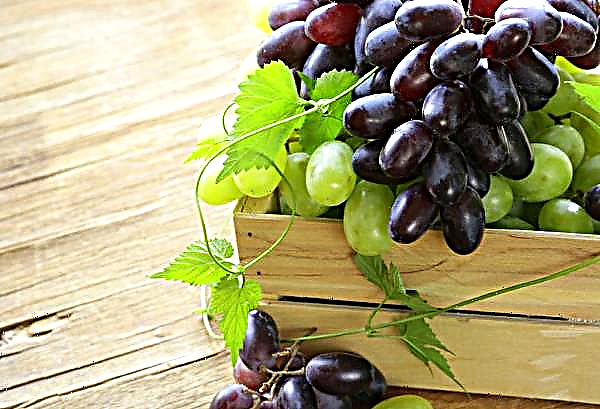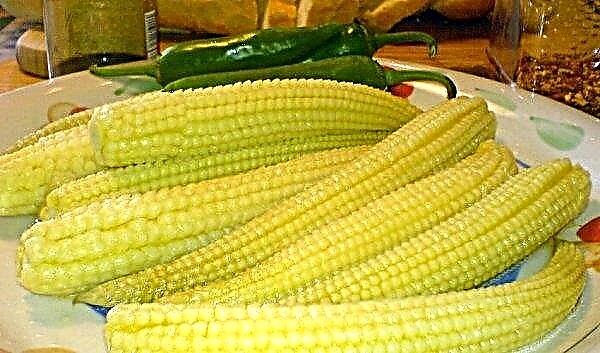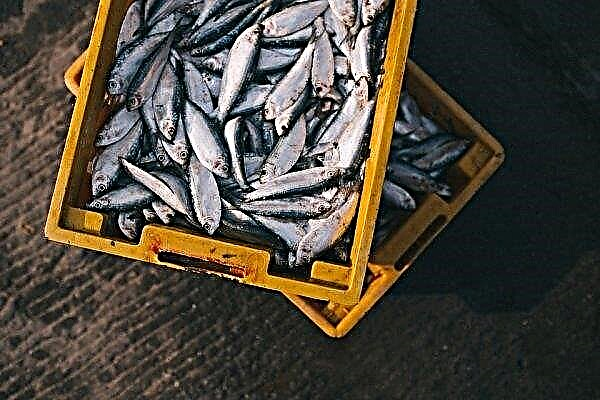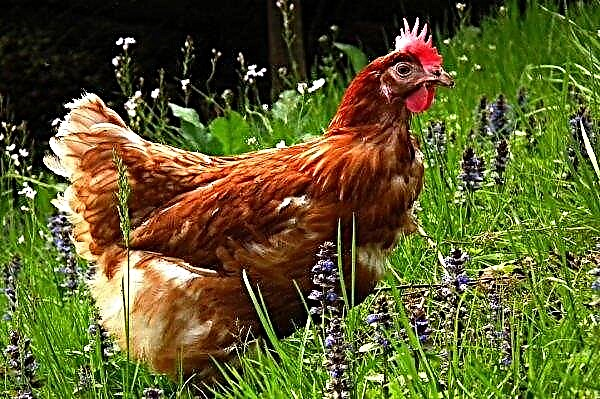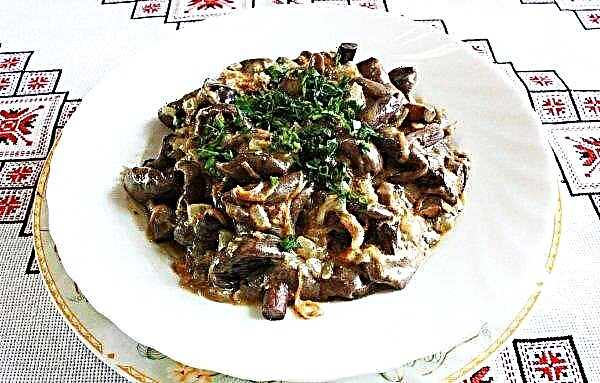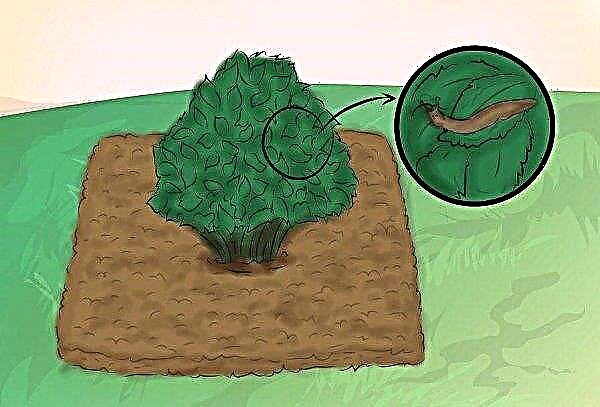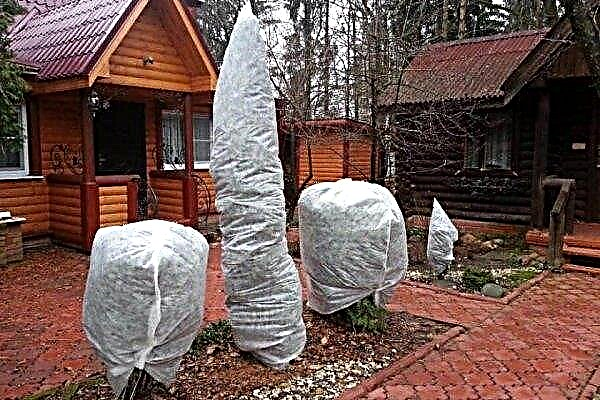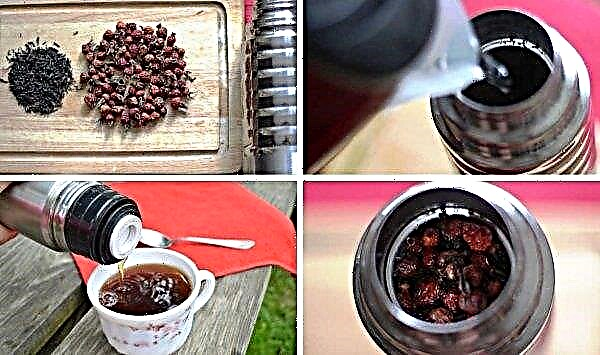Crimean pine is a vivid representative of conifers that adorn the picturesque nature of Crimea. This unpretentious in care, but a beautiful and always green tree has found application in landscape design. The article will tell you about what the Crimean pine looks like, where it can be planted and how it should be looked after.
Botanical tree description
Crimean pine, or Pallas pine (Pinus nigra pallasiana) is an evergreen coniferous tree that is a species of pine of the black family Pine genus Pine (Pinus). The habitat is Crimea and the south of the Caucasus. This tree belongs to centenarians. Its age can reach 550-600 years. It grows well on calcareous-sandy or crushed stone soil.
Prefers places well lit by sunshine. In shaded areas it weakly develops and grows, and is also often attacked by pests. This pine grows slowly - only 10-15 cm / year in height and 8-10 cm / year in width. It grows in length on average 20-30 m, but can reach 45 m.
The tree has a wide spreading crown in the form of a pyramid. Older specimens have a flatter umbrella shape. Branches are located horizontally to the trunk, and shoots grow in the direction of the top. The bark is colored black or dark brown, has cracks and grooves. Above it is more brownish-red. Young shoots are yellow-brown with a slight sheen.
Young shoots are yellow-brown with a slight sheen.The tree has large buds with straight scales. The dense coniferous cover is painted in dark green color. Thin needles with sharp ends reach a length of 10–12 cm, and in cross section have a diameter of 1.5–2.1 mm.
Cones sitting in branches, which can be arranged in a single order or several pieces, are painted in dark brown, have a glossy gloss and an egg-shaped shape, 5–10 cm long and 5–6 cm wide. Matured cones produce a seed that has a length 5-7 mm and black.
Video: Crimean Pine
Origin of name
The Crimean pine is called due to the fact that this tree naturally grows in the Crimea and is found most often. In England, culture was bred in 1799 from seeds that were transferred from the Crimea from the German natural scientist Peter Pallas. Hence its second name.
Peter Simon Pallas is a famous German scientist who, being in the Russian service, gained fame thanks to research expeditions in Siberia and southern Russia. Many species of animals and plants that he found and described were named after him.Did you know? The well-known representative of feline manul has a second name - "Pallas cat." There is also Pallas buttercup, Pallas honeysuckle and more. His name is called a volcano on the Kuril Islands and a crater on the moon.

Landing
It is important to choose the right soil, since the garden land is not suitable for Crimean pine trees. They prefer gravelly, calcareous, sandy soil. If there is a lot of sand in the soil, then clay should be added. The landing site should be well lit by the sun, so they should be planted from the south side.
It is better to purchase seedlings up to 5 years old - they adapt well to new growing conditions. It will be more difficult for older specimens to take root. Pine is planted in late April or late August.
Important! It is necessary to ensure that the root neck of the coniferous tree is at ground level. Otherwise, the plant will develop poorly and may die.
When planting a tree, it is recommended to adhere to the following sequence:
- Prepare the pit. To do this, dig a recess in the ground with a depth of 0.9–1 m and a width of 0.7–0.8 m. The depth should correspond to the length of the root system of the seedling.
- At the bottom of the pit, place a 20 cm drainage layer of crushed stone, broken brick or gravel. It is necessary to add 250-300 g of lime and 30 grams of fertilizer (nitroammofosk) or humus to the dug hole for planting.
- Prepare a nutritious mix of coniferous, soddy earth and sand, which are taken in equal parts.
- Carefully remove the seedling from the pot and place it in the center of the pit. Then fill it with earth, slightly tamping it.
 When planting several pines, the interval between them should be from 1.5 m. During a mass planting, a 3 × 5 m pattern should be followed.
When planting several pines, the interval between them should be from 1.5 m. During a mass planting, a 3 × 5 m pattern should be followed.
Pine care
It’s easy to take care of the Crimean pine. Particular attention should be paid only to young immature trees: they should organize watering and top dressing, pruning and soil care. For the winter, they should be covered with air-permeable material and mulch the soil. An adult plant will already tolerate winter and drought.
Did you know? Contrary to the idea of a pine tree as a northern tree, accustomed to severe frosts, not only the Crimean pine feels good in warm places. Caribbean pine grows further south, being a tropical species and found in the Bahamas, Jamaica and Cuba, in Guatemala, Mexico, Nicaragua.
Watering and feeding
This plant crop is quite drought-resistant and does not need watering, but young seedlings should not be watered until they get stronger. Moisturizing contributes to their faster rooting, growth and build-up of a denser coniferous cover. Young planting must be abundantly watered in the fall before the onset of frost, so that the trees tolerate the cold period well.
The first 2-3 years after planting, pine seedlings need to be fertilized so that they grow and develop better. It is quite enough to feed them at the beginning of the spring period. Mineral fertilizers with a nitrogen content are well suited for this purpose. It takes about 35–40 g for 1 seedling. After the granules are scattered around the tree, abundant watering is carried out to improve the flow of nutrients to the roots of the tree.
Adult specimens do not need to be fertilized, they lack nutrients from their own showered needles, which are around each pine. Therefore, it should not be removed.
Loosening and mulching
To improve the flow of air and nutrients, the trunk section is recommended to be loosened periodically after wetting. It is also necessary to remove weed grass, which prevents the plant crop from developing. It is advisable to carry out a shallow digging of the earth so as not to harm the root system of the trees.
To protect the earth from drying out, and to eliminate the growth of weed grass, it is recommended to mulch the trunk section. Fallen needles, bark of coniferous trees, sawdust, peat, humus are well suited as mulch. Mulching protects against fungal diseases.
Pruning
Crimean pine does not require the formation of a crown. It is only necessary to carry out pruning for sanitary purposes in the early spring - to remove dry and damaged branches. You can also carry out growth-stimulating pruning: for this, the shoots are cut one quarter of the total length. After such a procedure, the crown becomes more dense and magnificent.
Possible diseases and pests
Under adverse conditions (unsuitable soil, strong shade, rainy weather, etc.), the following diseases may occur in Crimean pine:
- crayfish;
- rust;
- different rot.

The main signs of the appearance of diseases are yellowing of needles, the appearance of plaque on the needles and bark, various formations on the trunk and so on. To avoid the appearance of such troubles, experts recommend that fungicidal preparations be treated in early spring. The main prevention is compliance with cultivation agricultural techniques.
Important! When purchasing planting material, be sure to carefully inspect the root system. It should not show any signs of insects or rot.
Of the insect pests, the trees are often attacked by May Khrushchev. It damages the roots of seedlings. To combat the May Khrushchev, chemical preparations such as "Aktara", "Skor" are used.
Another malicious pest is the bark beetle. He makes moves in the tree, which leads to its drying and death. This harmful insect can be detected by the appearance of a brownish color of powder on the trunk and main branches of the tree. To prevent the appearance of bark beetles, chemical preparations are carried out containing bifenthrin in early spring, as soon as the frosts are gone.
Silkworm larvae (caterpillars) that feed on coniferous needles can harm the pine. To combat them, spraying needles with "Actellicum", "Decis", "Karate" or "Actara" is used. To prevent the occurrence of these pests, it is recommended to carry out treatments in the early spring and autumn before the cold period with the same drugs.
The use of wood in landscape design
Crimean pine grows large and is great for landscaping parks and large land plots. From it you can plant an alley and green the streets of cities, since the plant tolerates gas contamination well. This tall tree exudes a pleasant smell of pine needles, which is good for human health, especially if there are problems with the respiratory organs. Pine can be planted alone near the house or in front of the entrance to the yard, but it is also good in group plantings. Next to it, other tall trees will look good - for example, black pine. Protective strips can be planted from this tree and their slopes strengthened.
Pine can be planted alone near the house or in front of the entrance to the yard, but it is also good in group plantings. Next to it, other tall trees will look good - for example, black pine. Protective strips can be planted from this tree and their slopes strengthened.
Thus, the Crimean pine is a fairly unpretentious tree that does not require constant care. But this plant culture can decorate any yard or park area and please with its pleasant aroma.


